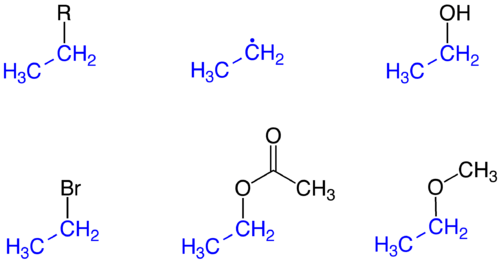Ethyl group
In chemistry, an ethyl group is an alkyl substituent derived from ethane (C2H6). It has the formula –CH2CH3 and is very often abbreviated Et. Ethyl is used in the IUPAC nomenclature of organic chemistry for a saturated two-carbon moiety in a molecule, while the prefix "eth-" is used to indicate the presence of two carbon atoms in the molecule.

Ethylation
Ethylation is the formation of a compound by introduction of the ethyl group. The most widely practiced example of this reaction is the ethylation of benzene with ethylene to yield ethylbenzene, a precursor to styrene, which is a precursor to polystyrene. Approximately 24.7 million tons of ethylbenzene were produced in 1999.[1]
Many ethyl-containing compounds are generated by electrophilic ethylation, i.e. treatment of nucleophiles with sources of Et+. Triethyloxonium tetrafluoroborate [Et3O]BF4 is such a reagent. For good nucleophiles, less electrophilic reagents are employed, such as ethyl halides.
Stereochemistry
In unsymmetrical ethylated compounds, the methylene protons in the ethyl substituent are diastereotopic. Chiral reagents are known to stereoselectively modify such substituents.
Etymology
The name of the group is derived from the Aether, the first-born Greek elemental god of air (and at that time a general term for any highly volatile compound) and "hyle", referring to "stuff". The name "ethyl" was coined in 1835 by the Swedish chemist Jöns Jacob Berzelius.[2]
See also
References
- Vincent A. Welch, Kevin J. Fallon, Heinz-Peter Gelbke "Ethylbenzene" Ullmann’s Encyclopedia of Industrial Chemistry, Wiley-VCH, Weinheim, 2005. doi:10.1002/14356007.a10_035.pub2
- In 1834, the German chemist Justus Liebig had argued that the group C2H5 constituted a "radical" (a cluster of atoms that did not undergo changes during chemical reactions). (See: Justus Liebig (1834) "Ueber die Constitution des Aethers und seiner Verbindungen" (On the composition of ethers and their compounds), Annalen der Pharmacie, 9 : 1–39.) In reporting on Liebig's findings (and related work by others), Berzelius coined the names "methyl" and "ethyl" for the "radicals" CH3 and C2H5, respectively. From Jacob Berzelius, Årsberättelsen om framsteg i fysik och kemi [Annual report on progress in physics and chemistry] (Stockholm, Sweden: P.A. Norstedt & Söner, 1835), p. 376: "Man får då ge namn åt etherradikalerna; man kan kalla den äldre C4H10, ethyl, den nyare C2H6, methyl, … " (One may then give names to ether radicals; one can call the older [one] C4H10, ethyl, the newer [one] C2H6, methyl, … [Note: At that time, chemists used the wrong atomic masses (e.g., 6 for carbon instead of 12); hence the coefficients shown here must be divided by two.]) In his translation into German of Berzelius' report, the German chemist Friedrich Wöhler transliterated "ethyl" as "Aethyl". (See: Jöns Jacob Berzelius with Friedrich Wöhler, trans., Jahresbericht über die Fortschritte der physischen Wissenschaften (Annual report on the progress of the physical sciences), 15 : 381.)
